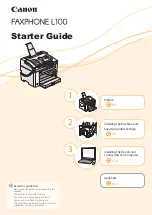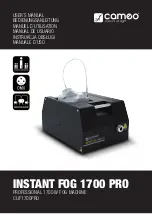
4-6
4.4
WASH-AND-DRY MACHINE IN
OPERATION
1.
During operation, check the state of the batteries
charge to avoid flat batteries in inaccessible battery
recharge points.
2.
Check also periodically the residual quantity of
detergent solution (or water for washing), through its
level indicator.
3.
If the water recovery tank fills during use of the wash-
and-dry machine, suction is automatically stopped.
To start suction again, it is necessary to empty the
water recovery tank (see related paragraph).
4.
If necessary, at the end of the operation, proceed with
emptying the tanks (see related paragraph).
4.5
AFTER MACHINE USE
At the end of the work, before leaving the machine:
Disconnect the brush in the following way:
1.
Empty the tank of water recovery, as listed in the
following paragraph.
2.
Clean the disc brush (or cylindrical brushes) and the
squeegee, as listed in the Maintenance Chapter.
3.
If necessary, recharge the battery as listed in the
Maintenance Chapter.
4.
Leave the machine in a dry and clean place, with
brush and squeegee lifted.
4.6
EMPTYING THE TANKS
Emptying the tank from water recovery
1.
Take the wash-and-dry machine to the suitable area
for draining the water recovery, in full compliance of
the anti-pollution regulations in force.
2.
Disengage the hose (1, Figure 4-3) from its seat and
raise it beyond the upper edge of the tank until its
area (2) is water free; then, by keeping it in this
position, unscrew the stopper (3).
3.
Bend manually the hose in the area (2) until obtaining
a watertight fold (17); then, by keeping it bent, lower
it on the drain area.
4.
Release gradually (in order to avoid undesired
squirts) the fold (17) by letting the dirty water flow out
from the tank into the drain area.
5.
With the handle (4, Figure 4-3), raise the cover of the
tanks (5) and, if necessary, wash the water recovery
tank (6); wash also the related lower side (7) of the
cover and perimeter gasket (8).
Check that the perimeter gasket (8) is whole: if
damaged, it can jeopardise the good functioning of
the dirty water suction.
6.
Let all the water for washing flow out of the hose (1,
Figure 4-3), then screw the stopper (3) and engage
the hose (1) on its seat in the wash-and-dry machine.
Detergent solution (or water for washing) tank
emptying
7.
Take the wash-and-dry machine to the suitable area
for draining the detergent solution (or water for
washing), in full compliance of the anti-pollution
regulations in force.
8.
Disengage the hose (10, Figure 4-3) from its seat
and raise it beyond the upper edge of the tank until its
area (11) is free from water; then, by keeping it in this
position, unscrew the stopper (12).
9.
(Only for optional hose that can be pressed in the
area (11)): Bend manually the hose in the area (11)
until obtaining a watertight fold (17); then, by keeping
it bent, lower it on the drain area.
Release gradually (in order to avoid undesired
squirts) the fold (17) by letting the detergent solution
(or water) flow out from the tank into the drain area.
WARNING!
Do not damage the float (9, Figure 4-3)
Summary of Contents for E Ride 21
Page 2: ......
Page 13: ...3 3 Figure 3 1 11 10 12 14 18 3c 3a 3d 3b 21 20 3 7 6 13 15 17 9 19 16 4 2 5 1 8...
Page 15: ...3 5 Figure 3 3 19 14 13 21 15 16 17 18 27 28 20 9 6 8 24 23...
Page 20: ...3 10...
Page 35: ...5 7 Figure 5 7 2 2 1 4 3...
Page 41: ...5 13 Figure 5 12 2 4 1 7 4 3 5 8...
Page 43: ...5 15 Figure 5 14 Figure 5 15 5 3 4 3 1 4 2 4 4 3 1 4 4 2 4 4 5...
Page 48: ...6 2...
















































